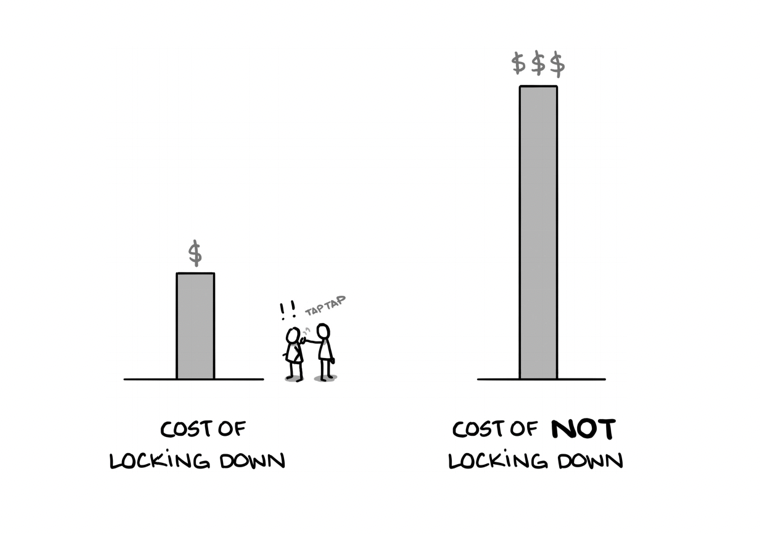
“We didn’t understand that it’s a fairly low fatality rate & that it’s a disease mainly in the elderly, kind of like flu is, although a bit different than that.”
Bill Gates
Imagine yourself sidled up to a bar. A talkative guy sits down on the stool next to you. He has decided that there is one thing wrong with the world. It can be literally anything. Regardless, he has the solution.
It’s interesting and weird for a few minutes. But you gradually come to realize that he is actually crazy. His main point is wrong and so his solutions are wrong too. But the drinks are good, and he is buying. So you put up with it. In any case, you will forget the whole thing in the morning.
In the morning, however, you realize that he is one of the world’s richest men and he is pulling the strings of many of the world’s most powerful people.
Now you are alarmed.
In a nutshell, that’s what it’s like to read Bill Gates’s new book How to Prevent the Next Pandemic. The main theme is implied in the title. With enough money, intelligence, and power, along with technological know-how at the helm, the next pathogen to come along can be stopped in its tracks. Where the bug goes after that he never explains. Presumably it just disappears. Like a computer virus, it exists but doesn’t ruin your harddrive.
What are the historical examples of such a thing? There are none via avoidance, testing, contract tracing, and control of the human population. This theory of virus control – the notion that muscling the population makes a prevalent virus shrink into submission and disappear – is a completely new invention, the mechanization of a primitive instinct.
Smallpox occupies a unique position among infectious diseases as the only one affecting humans that has been eradicated. There are reasons for that: a stable pathogen, a great vaccine, and a hundred years of focused public health work. This happened not due to lockdowns but from the careful and patient application of traditional public-health principles.
Can that same experience be repeated in every case? It’s worth investigating and thinking about. The reason is that the attempt to crush a respiratory virus through universal avoidance could be worse than allowing endemicity to it to develop throughout the population.
Eradication is not the same thing as perpetual pathogenic avoidance. The former is great but the latter is deeply dangerous: the only thing more dangerous to human life than governments is a naive immune system. Gates’s plan, even if it had a chance of working which it does not, could create exactly that. Not to understand the difference is an egregious intellectual error.
The error here probably traces to Gates’s fundamental confusion. He doesn’t say this in the book but it becomes very apparent that he thinks a biological virus works just like a computer “virus.” He seems not to know that the application of this term to computing is purely metaphorical.
The goal of computer security is to block all viruses no matter what. Applying that same principle to human biology would create calamity. That’s because pathogens do not disappear when everyone complies with the rule of “stay home and stay safe.” They are still waiting out there, looking for vulnerable people to infect. With a virus like SARS-CoV2, this keeps happening until we reach herd immunity. The less exposed a population is to a mostly mild pathogen, the more vulnerable they are in the future to more severe outcomes.
Please don’t get bored with this review because you already know this. It is taught to everyone in 9th grade biology class. And there’s no sense in repeating this here, much less explaining the basics of human immunology.
The point, sadly, is that Gates somehow avoided this knowledge his entire life. He wants to scrub the human body the way he worked to scrub the Windows operating system. It’s the kind of basic error anyone would make who has surrounded himself with sycophants for the better part of his career.
If you understand this one simple point about Gates’s thinking, you get the entire book. All that matters is avoidance. The more avoidance the better. There is no such thing as being too free of pathogenic exposure. To him, the single goal of all public health is to keep the population away from as many germs as possible.
So yes, I’m sorry to report that the entire book is a study in mysophobia, more worthy of study by a student of abnormal psychology than a public health official, much less a scientist. That no one has ever pointed this out to him is a disgrace. It’s the trouble with being so rich that you become uncriticizable.
The very rich can make for fascinating character studies. Not all but many. I’ve known a few and had the chance to get to know their thinking. Too often they conclude their own life successes are due to their extraordinary prowess and ability to depart from conventions, never pure luck or good intuition.
That’s partly correct but the realization can create an eccentric habit of mind. They can conclude that all known knowledge and conventions should be presumed to be wrong. If you believe this, you are often only a small step away from full-blown crankism. The history of phrenology, eugenics, and countless dietary cults proves that.
The danger here of course is that they can also exercise outsized influence over others due purely to the size of their bank accounts and their demand that everyone around them behave in ways that are insufferably obsequious. To be at such a dinner party with a person like this, having kissed the ring for hours, means breathing a huge sigh of relief once you are in the car headed home.
In any case, we all know that Gates is a main promoter and funder of lockdown ideology. It’s been going on for the better part of 15 years. No surprise that has gained converts to this view. But one might suppose that after the world calamity this ideology created, he would be rethinking things. Maybe he is just a bit. It’s hard to tell.
Here is what the book says.
- The Chinese government had taken unprecedented safety measures to lock down Wuhan, the city where the virus emerged—schools and public places were closed, and citizens were issued permission cards that allowed them to leave their homes every other day for thirty minutes at a time.
- During the first wave of COVID, Denmark and Norway implemented strict lockdowns early on (when fewer than thirty people in each country had been hospitalized), while the government of neighboring Sweden relied more on recommendations than requirements, keeping restaurants, bars, and gyms open and only encouraging but not requiring physical distancing. One study found that if Sweden’s neighbors had followed its lead instead of locking down stringently, Denmark would have had three times as many deaths as it did during the first wave, and Norway nine times as many as it did. Another study estimated that NPIs in six large countries, including the United States, prevented nearly half a billion COVID infections in the first few months of 2020 alone.
- Even though lockdowns have clear benefits for public health, it’s not always clear whether in lower-income countries they are worth the sacrifice. In such places, closing down sectors of the economy can lead to acute hunger, drive people into extreme poverty, and increase deaths from other causes. If you’re a young adult and spend your day working outside—as many people in low-income countries do—COVID will not seem as scary as the possibility of not having enough food to feed your family.
- The human suffering caused by these separations is incalculable, literally—no one can put a number on the pain of not being able to say goodbye in person. But the policy saved so many lives that it will be worth adopting again if the circumstances call for it.
- Lockdowns are a great example. The evidence is clear that they reduce transmission, and that stricter lockdowns reduce transmission more than looser ones do. But they’re not equally effective everywhere, because not everyone is able to comply by staying in one place.
- Lockdowns may not be necessary in places where the disease burden is modest. They’re also more effective in countries where residents have less of a voice in the country’s affairs,and the government is in a position to strictly enforce lockdowns and other mandates. What this all means is that there is no single ideal mix of NPIs that works equally well everywhere. Context matters, and protective measures need to be tailored for the places where they’ll be used.
- This is good news, because NPIs are our most important tool in the early days of an outbreak. There’s no lab time required to put mask mandates in place (assuming we can provide the masks), figure out when to cancel big public events, or limit how many people can sit in a restaurant. (Though we will need to make sure that whatever NPIs we deploy are appropriate to the pathogen we’re trying to stop.)
- The economy was bad when businesses shut down, but it could have been even worse if the virus had been allowed to run rampant and kill millions more people than it already had. By saving lives, lockdowns can make it possible to start the economic recovery sooner.
And here he adds a little graphic.

- The pandemic forced us to rethink what is acceptable for many activities. Digital alternatives that were once viewed as inferior were suddenly seen as preferable.
- I want to add a caveat to the idea that long-term school closures shouldn’t be necessary. That will be true if the next outbreak is one with a profile like COVID’s—in particular, one that rarely makes kids severely ill. But we have to be careful not to get caught fighting the last war. If a future pathogen is markedly different from COVID—if, for instance, its impact on children is a lot worse—then the risk/benefit calculus could change, and closing schools might be prudent. We’ll need to stay flexible and, as always, follow the data.
- Also, not all overreactions—or apparent overreactions—are created equal. Closing borders, for example, did slow the spread of COVID in some regions. But border closures are a hammer that needs to be wielded very carefully. By cutting off trade and tourism, they can crater a country’s economy so badly that the cure becomes worse than the disease.
- It’s stunning how little we know about superspreaders. What role does biology play? Are some people more prone to being a superspreader than others? There’s also certainly a behavioral component. Superspreaders seem not to pose more of a risk to small groups than other infected people do, but in crowded indoor public spaces, such as bars and restaurants, there’s a better chance that you’ll encounter one or more superspreaders, and they’ll have the opportunity to infect a lot of people. Superspreaders are one of the mysteries of disease transmission that needs a lot more study.
- In the meantime, the six-foot rule is a good one to follow, unless it’s very difficult to maintain, such as in a classroom. People need clear, easily remembered guidelines. It is not a helpful public health message to say, “Keep your distance, but the exact distance depends on the situation, so it might be three feet, or six feet, or maybe more.”
- The quick rollout of PCR tests and quarantine policies explains in large part why some countries, such as Australia, had dramatically fewer infections and excess deaths than others. Governments need to learn from these examples and figure out how they will ramp up testing very quickly—and give people an incentive to get tested by also offering treatment to anyone who tests positive and is at significant risk of severe disease.
- This is a little hard to admit, because the power of inventing things is so central to my worldview, but it’s true: We may never devise a cheaper, more effective way to block the transmission of certain respiratory viruses than a piece of inexpensive material with a couple of elastic straps sewn onto it.
- The real benefit comes with universal masking, where both people are double masking or improving the fit of their surgical masks: It reduces the risk of exposure by 96 percent. That’s an incredibly effective intervention that can be manufactured for just a few cents.
- If everyone had masked up early on—and if the world had had enough supplies to meet the demand—it would have blunted the spread of COVID dramatically.
I’m not going to fact check the above simply because we do this every day on Brownstone. Suffice it to say that much of what he claims is unproven or completely false.
What matters here is the big picture. To me, he seems to be saying that in an ideal world, we would live with rolling lockdowns forever, on the say-so of experts in his pay. Indeed, he proposes the creation of a new division of the World Health Organization, staffed with 3,000 employees.
I call it the GERM—Global Epidemic Response and Mobilization—team, and the job of its people should be to wake up every day asking themselves the same questions: “Is the world ready for the next outbreak? What can we do to be better prepared?” They should be fully paid, regularly drilled, and prepared to mount a coordinated response to the next threat of a pandemic. The GERM team should have the ability to declare a pandemic and work with national governments and the World Bank to raise money for the response very quickly.
Just in case you think this is about helping sick people to get well, Gates corrects you: “You might have noticed one obvious activity that’s missing from GERM’s job description: treating patients. That’s by design.”
Oh.
Presumably, if we can ever claw our way back to traditional public health, we will also return to things like treating patients rather than brutalizing populations in the name of achieving what is not only impossible but also undesirable: the creation of a pathogen-free world.
This book deserves a more extensive critique, especially the claim that urbanization and travel make the world a dirtier and less healthy place, a view exactly aligned with Fauci’s own. The opposite is likely true but you have to have the subtle mind of Sunetra Gupta to understand why.
All that said, I’m glad Gates put pen to paper. Just like finding yourself sitting at a bar with a crazy person, such an experience can be very interesting, provided the drinks are flowing and he is picking up the tab. Just don’t put them in charge of anything. Otherwise, we will in fact lose all voice in public affairs, exactly as Gates seems to desire.
Thank you @BillGates for sending a copy of your new book. I fully agree that we must act on #COVID19’s lessons and innovate so that we can deliver swift, equitable health solutions to prevent the next pandemic. @gatesfoundation pic.twitter.com/E69PyBdgB9
— Tedros Adhanom Ghebreyesus (@DrTedros) April 15, 2022
Jeffrey A. Tucker is Founder and President of the Brownstone Institute and the author of many thousands of articles in the scholarly and popular press and ten books in 5 languages, most recently Liberty or Lockdown. He is also the editor of The Best of Mises. He speaks widely on topics of economics, technology, social philosophy, and culture.
